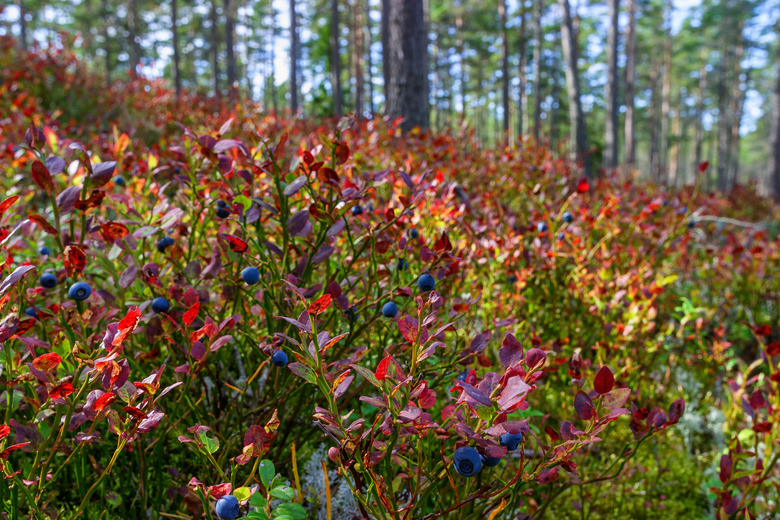What Do Wild Blueberry Bushes Look Like?
We may receive a commission on purchases made from links.
Wild blueberries belong to the Vaccinium genus and are loved for the sweet-tart fruits they produce in mid to late summer. As their common name suggests, wild blueberries can be found in nature, in abandoned fields, along the side of the road, in forests, and on mountainsides. These hardy plants spread through seeds and the development of rhizomes, or underground stems.
Branch, Foliage, and Fruit Production
Branch, Foliage, and Fruit Production
All wild blueberries produce blue-black, round fruits, which are their most distinctive characteristic. The fruit has a five-pointed crown on the underside of the berry. The berries produced by the wild plants are smaller than cultivated berries, roughly 1/4 inch in diameter, and they contain small, soft seeds. They are said to be rich in antioxidants and are used to make nutritional supplements.
If it isn't berry season yet, recognize wild blueberries by their thin branches and spring flowers that range from white to light pink in color. The leaves are green and broad with a defined point, and they turn bright red in the fall.
Species of Wild Blueberries
Species of Wild Blueberries
The two primary species of wild blueberries that grow in North America are the lowbush blueberry (Vaccinium angustifolium) and the sour top (Vaccinium myrtilloides). The sour top is a larger shrub, reaching a height of 6 to 24 inches, while the lowbush blueberry grows 3 to 15 inches high.
Both shrubs produce berries that are dusky blue. The berries of a sour top bush have a waxy coating on the outside, while the lowbush has a powdery-looking coating. Names don't lie; sour top berries are less sweet than the lowbush blueberry.
Where to Find Wild Blueberries
Where to Find Wild Blueberries
Wild blueberries are hardy in U.S. Department of Agriculture plant hardiness zones 2a through 8a. Where to find them in the wild depends on the species.
The lowbush blueberry can be found in fields and forests, while the sour top grows mostly in woodlands. While wild blueberries grow throughout the United States, they are most prevalent in Maine and New Jersey.
Wild blueberries are safe to eat but taste best when fully ripened. To test for ripeness, tickle the fruit bunches and eat only the fruit that falls off easily. Blueberries are not fully ripe until several days after they turn blue. When harvesting wild berries, be aware that it's easy to misidentify them, and not all berries are edible. Do not eat berries that you can't definitively identify.
Blueberries vs. Huckleberries
Blueberries vs. Huckleberries
Blueberries are commonly mistaken for huckleberries, another wild shrub that produces small blue fruits. Blueberries are lighter in color than huckleberries, although the size and shape of the fruits are similar. Huckleberries grow more densely than wild blueberries, which tend to have a creeping growth habit, and they are much taller, reaching upward of 4 feet high.
The flowers are bell-shaped on the huckleberry plant, and the leaves turn a dark gold to red-purple in the fall. The seeds of the huckleberry fruit are harder than blueberries, and there are 10 seeds per berry. Huckleberry plants are found more commonly in the Pacific Northwest and the Northeast, growing mainly on mountainsides.
